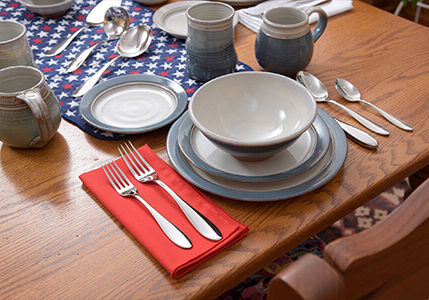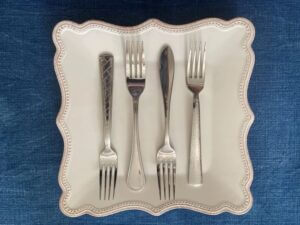Finding Flatware That’s a Cut Above By Marni Jameson

Blog Article By Marni Jameson – Originally posted on At Home With Marni Jameson
Part One
Now here’s something to chew on. What common household item do you hold and put it in your mouth 50 times a day? That’s more than your toothbrush. And when was the last time you thought about it?
I hadn’t paid my flatware much attention since I bought it 30 years ago. It’s just been there, in the drawer, waiting to transport food to my mouth, which I appreciate. But recently I discovered I had half as many forks and spoons as knives. What happened? We started out with the same number of each.
“The forks ran away with the spoons!” I cried to Greg Owens, co-owner of Sherrill Manufacturing, the last remaining maker of flatware in the United States, which is why I thought he might care. (You do you, but I feel good about supporting American-made products.)
Owens, who unlike me, actually does give flatware a lot of thought, had heard this before. “Forks and spoons often get lost to trash cans, lunch sacks, picnics and camping trips,” he said, then launched into a little history.
He told me how he and his partner Matthew Roberts, both veterans of the steel business, stepped up when, in 2005, Oneida Limited, one of the world’s leading flatware manufacturers, closed its U.S. manufacturing plant, which had been making silverware since 1860 (think Abraham Lincoln), and moved all operations offshore.
“Oneida could buy finished flatware made in China cheaper than it could buy the metal to produce their product in the United States, so they left,” Owens said.
Owens and Roberts took over the manufacturing facility, continued to employ many of the workers, and christened the new operation Sherrill Manufacturing, named after the city in New York, where it’s based. A few years later, they began making Liberty Tabletop flatware, which now sells 33 different patterns online direct to consumers.
Now, alert readers will recall that last week’s columns about household goods you should not buy online had flatware on the list. You need to see and feel it in person before committing. You won’t get an argument from Owens, who encourages customers to order samples. Yet direct online selling is what makes it possible for Liberty to compete on price with imports. “We can bypass retail stores, which often take as much as 70 percent of the profit,” he said.
Given that 90 percent of the flatware sold in America today comes from China, Owens takes pride saying, “We are 100 percent American. We use hydro power from Niagara Falls, get our metal from Pittsburgh, so we know it meets U.S. quality standards, no mystery metal, and we provide American jobs.”
But back to me.
I still had a serious fork and spoon problem. I checked online at Replacements Unlimited, the company that sells individual pieces of china, crystal and silverware for folks who’ve broken or lost pieces or have gaps in their sets. No luck. I found the brand of my old flatware, but not the style.
Which meant only one thing: New flatware. As I began shopping for something I hadn’t bought in decades, and likely won’t ever buy again, I figured I’d better learn what I should look for. Here’s what I discovered makes the cut:
· Material. The key quality to look for when choosing stainless-steel flatware is the metal content. The back usually has a stamp that reads 18/10, 18/8 or 18/0. This ratio represents the amount of chromium to nickel in the metal alloy. Nickel (the second number) gives utensils their luster and durability, and reduces their susceptibility to pitting, rusting, clouding and staining. Because nickel is expensive, many manufacturers skimp. Today, most imports are 18/0, said Owens, whose company makes only 18/10 flatware.
· Production quality: Beside metal ratio, another way to judge flatware is by the quality of its finish. Pieces should have an even luster with no pitting, no irregular pattern detailing, and no areas that appear worn down or over buffed. Look between the fork tines. An inferior product will show roughness there.
· Style. Flatware designs fall into three categories: Modern, which is sleek and streamlined with little or no pattern. Traditional, which often features floral designs, ornate flourishes and fiddleback or curved outlines. And decorative, where handles incorporate textures such as hammered, stippled or woven effects, or colored, non-metallic handles, which tend to be less durable. Pick something you won’t get tired of. That said, Liberty offers an affinity line with fun motifs that feature skulls (a hit with the biker set), Celtic heritage, and Woodstock (a hippie flashback).
· Finish. Today’s flatware comes with polished, brushed, or ornate finishes. The smoother the finish and the simpler the pattern, the more it will show fingerprints, dings and scratches, “and that’s not necessarily bad,” Owens said. Patterned flatware is more forgiving.
· Size. Flatware size falls into two general camps: American Standard and European. American standard flatware is typically an inch smaller than European-sized pieces. For example, an American Standard fork measures about seven inches, while its European counterpart measures eight inches. Though some U.S. consumers still prefer traditional American sizing, the trend is toward less ornate, larger and heavier pieces, known in the industry as Euro-sizing. The only way to know what you like best is to try before you buy.
Because there’s more to this story, join me next week when my husband and I test drive four flatware sets and discover, and sometimes disagree on, their finer points. (Featured in Part Two below.)
Read the original Part One blog article by Marni Jameson here.
Part Two

PHOTO CAPTION: Get a grip ― When testing out flatware, be sure to physically handle it, and also see how the pattern gets along with your dishes. Here, the author tests four sample fork patterns before committing. Photo courtesy Marni Jameson.
Here’s why I will never become rich as a home design columnist. Because, far too often, when I go out to investigate some aspect of better living, I wind up buying into it. Literally.
Which brings me to my new flatware.
Upon learning that 30 years of sack lunches and summer picnics had decimated my silverware drawer to the point where I was down to five forks from the original16, I found myself in the flatware market. That’s when it struck me like a meat cleaver in the forehead that although I had written columns about many common categories of kitchenware – pots and pans, wineglasses, kitchen knives, table linens – I had never – we had never – talked about our everyday flatware.
How had I missed this? Is there anything in the kitchen more personal than the utensils we hold and put in our mouths? Off I went to research land to find out what I (we) should look for when choosing flatware. I shared the basics last week, but there’s more to know before making what could amount to a lifetime decision.
“Apart from what you may have filched from the college cafeteria, (who me?), flatware is one of those purchases you typically only make twice in your life,” said Greg Owens, co-owner of Sherrill Manufacturing, which makes Liberty Tabletop flatware, the only flatware still made in America.
“You buy once when you leave the dorm for your first real apartment,” he said. “You go to Walmart and get a 40-piece place setting for $29.95. You buy again, maybe, when you grow up and settle down.”
I guess I’m finally grown up.
Owens’s typical customer is a female over 40 who cares about setting a nice table. Not surprisingly, genders approach the decision differently, he added. “When men judge flatware, they pick up the knife to feel how heavy it is. Women look at the details of the dinner fork.”
After my conversation with Owens, I decide to try out his company’s sample program. I open my laptop to the flatware page, which features 33 patterns. I loop in my husband, who, inconveniently, has opinions on such matters. He picks two patterns, and I picked two. A few days later the samples arrive, and the fork-to-fork competition ― a lengthy, deeply analytical discussion ― begins.
At one point, each pattern was in the lead, but, as in a close horse race, the front runner would drop back, to be overtaken by the horse in third place. In the end, my husband liked one set that had a woven texture. I liked another, that was mirror shiny and sleek. The two contenders faced off over dinner. The discussion continued. These are big stakes, people! In the end, he deferred. It may have been when I said, “but my reputation is at stake.” Dire wins the day. “Okay,” he said, “as long as we can get solid knife handles.”
Done.
In addition to the flatware basics we covered in last week’s column (material, style, size, and finish), here’s what else to consider when buying this household staple:
· Feel. When selecting the silverware you will hold every day, pay attention to how it feels in your hand. Pick up a piece and get a sense of its balance, weight and contours. During our sample test, DC ruled out a fork because the sides of the handle were square, not rounded, and felt sharp against his fingers. Contours should feel pleasant to hold. Heft is also important. You don’t want your flatware to feel like the flimsy stuff found in school cafeterias. “It should pass the ice cream test,” Owens said. “You should be able to scoop hard ice cream without bending the spoon.”
· Compatibility. Your flatware should get along with your dishware. We set each sample pattern alongside both our nice dishes and our everyday dishes to see how the combination worked. Some patterns fought while others harmonized. Usually, if your dishes are simple, your silverware can be more ornate, though plain also works. Conversely, a patterned plate may look better with simpler silverware. Mixing patterns is tricky. Trust your eye.
· Wearability. Both mirror and satin finishes will show wear sooner than ornate finishes, but that’s all part of the patina. “The mirror finish ends up with darker scratches, and the satin finish ends up with bright scratches,” Owens said. “Ornament on handles will almost always hide scratches and dings, so tend to hold onto their newness longer.” Regardless, proper handling is important. “Don’t dump your flatware in a sink with 100 other pieces banging around, and when putting it in the dishwasher, use separators in the cutlery baskets.”
· Practicality. DC and I eliminated my original favorite pattern because the base of the utensils was too wide to fit in the slots of our dishwasher’s silverware basket.
· Hollow or solid? Here’s a debate topic to rival the chocolate or vanilla wars. The world of flatware has two types of knife handles. Hollow-handled knives, where two halves of the handle come together around the tang of the blade. Artisans solder the halves together and fill the hollow with epoxy or cement. In solid-handle knife construction, knives are forged out of one solid piece of steel. Solid-handled knives are stronger, but hollow-handled knives are more balanced, so less likely to fall off the edge of a plate.
We ordered a 65-piece place setting of the Betsy Ross pattern, which is modern yet classic, with solid knife handles, to make DC happy, and extra serving pieces, providing yet another example of how my pursuit of better living comes at a price.
Read the original blog article Part Two by Marni Jameson here.
